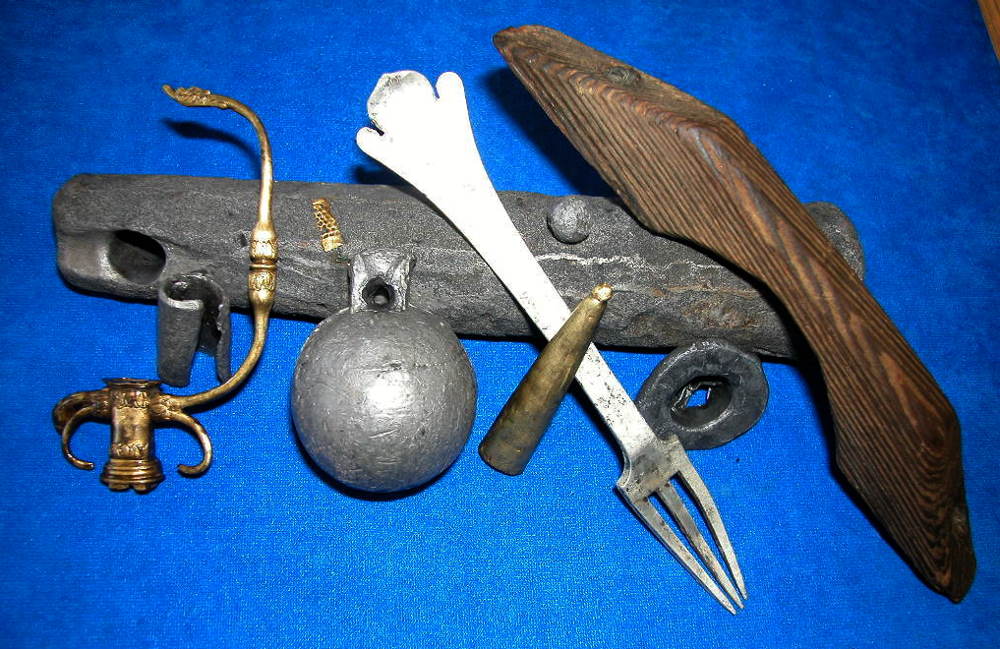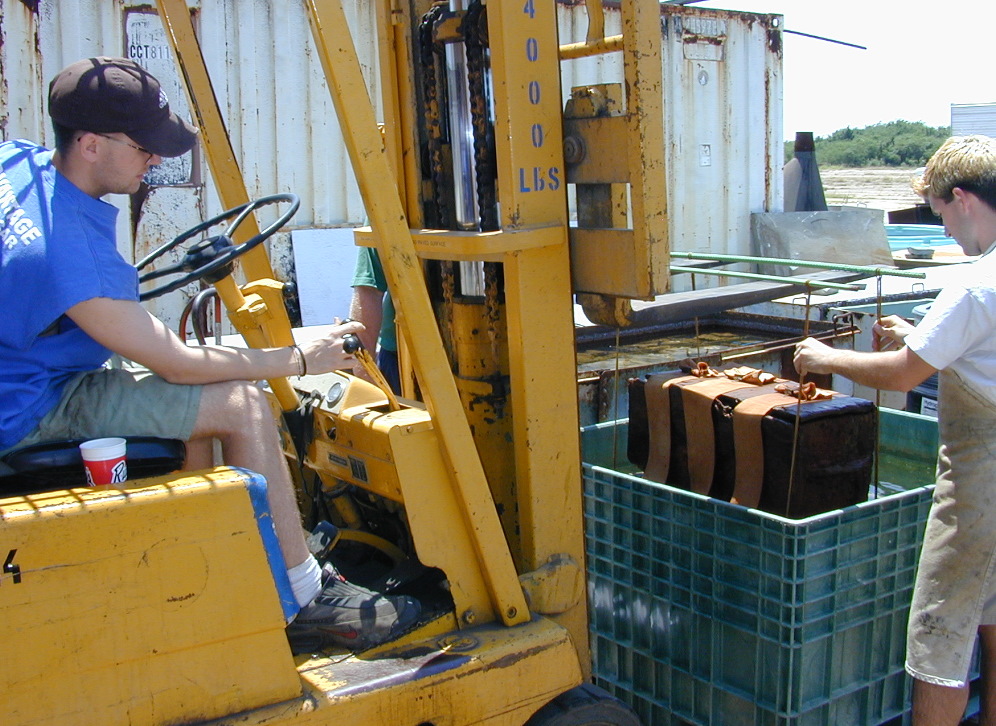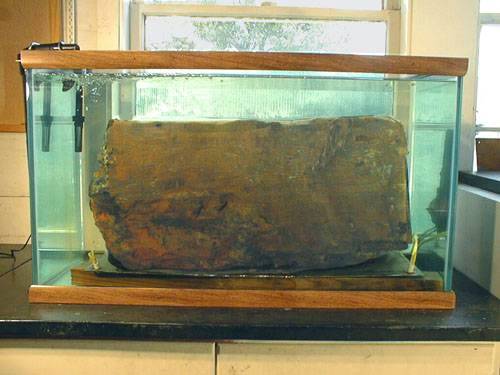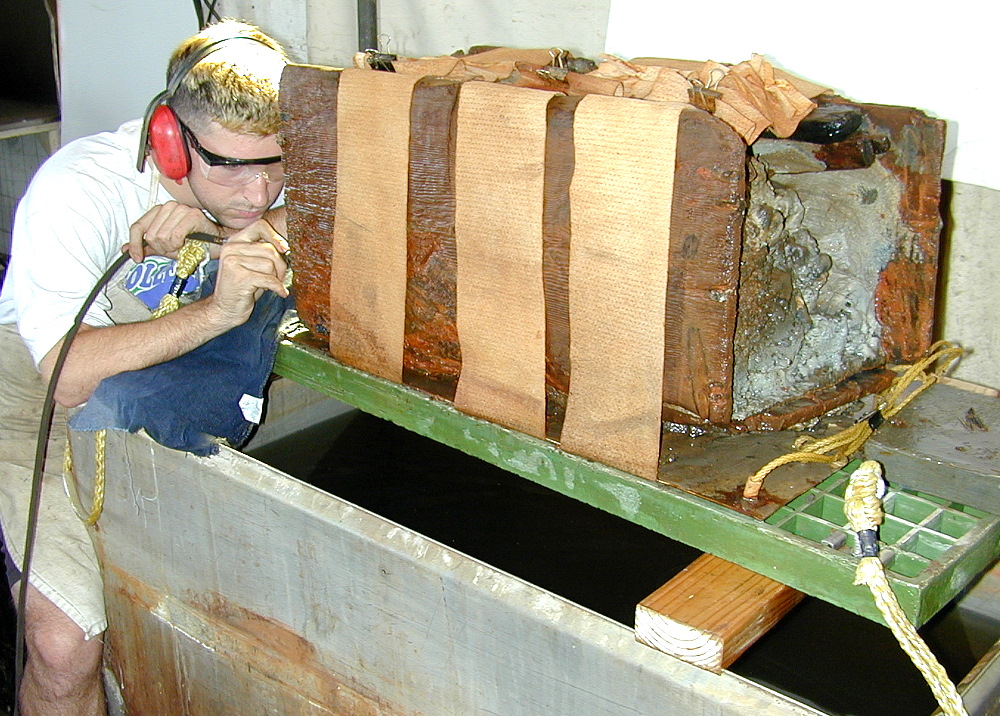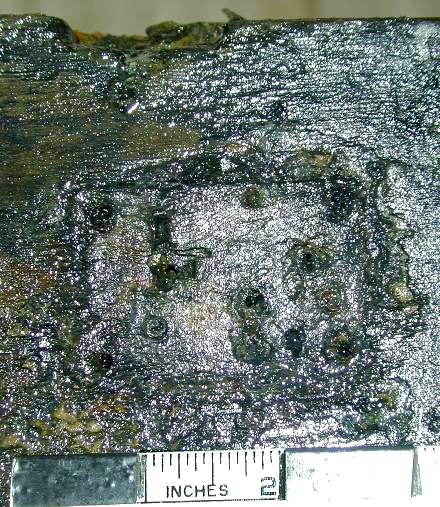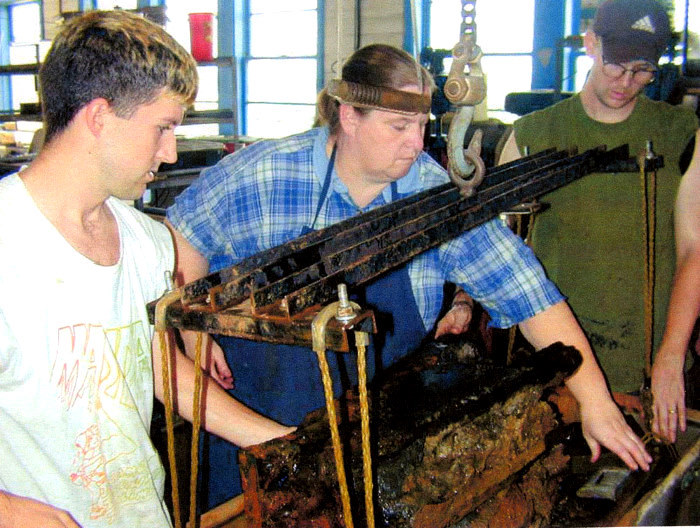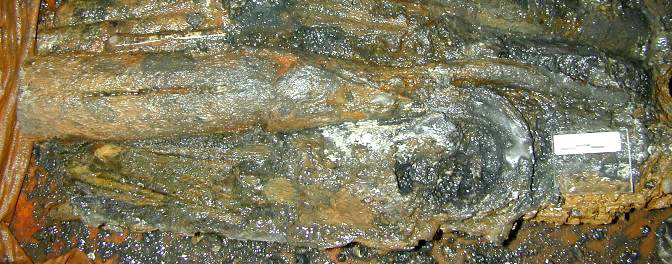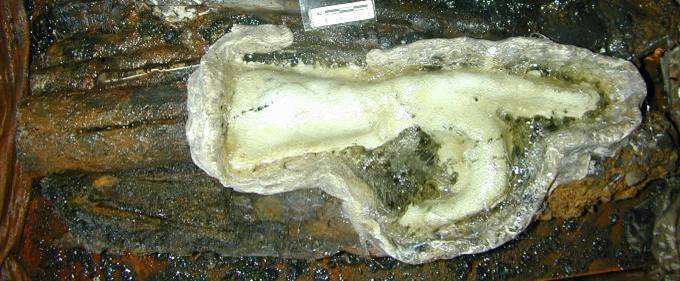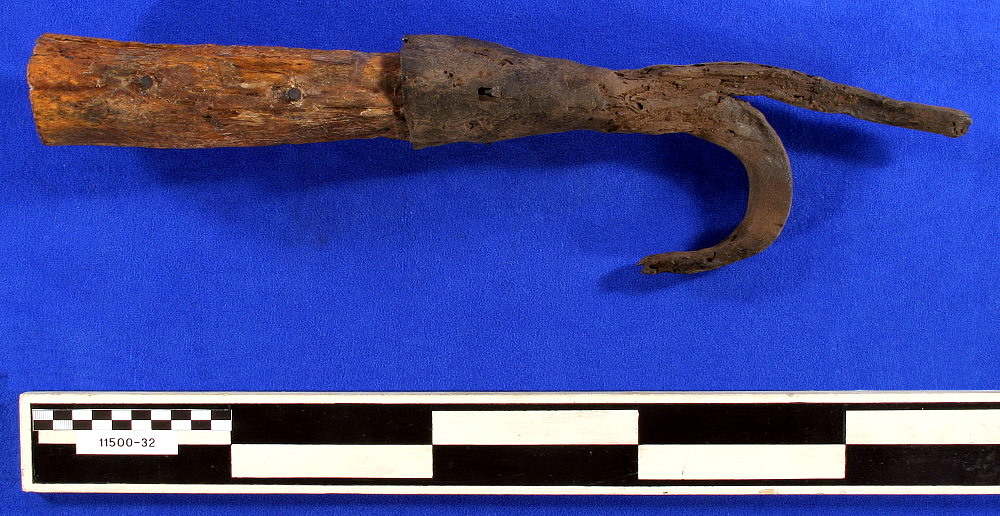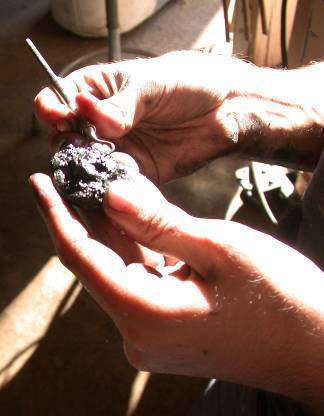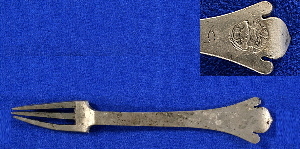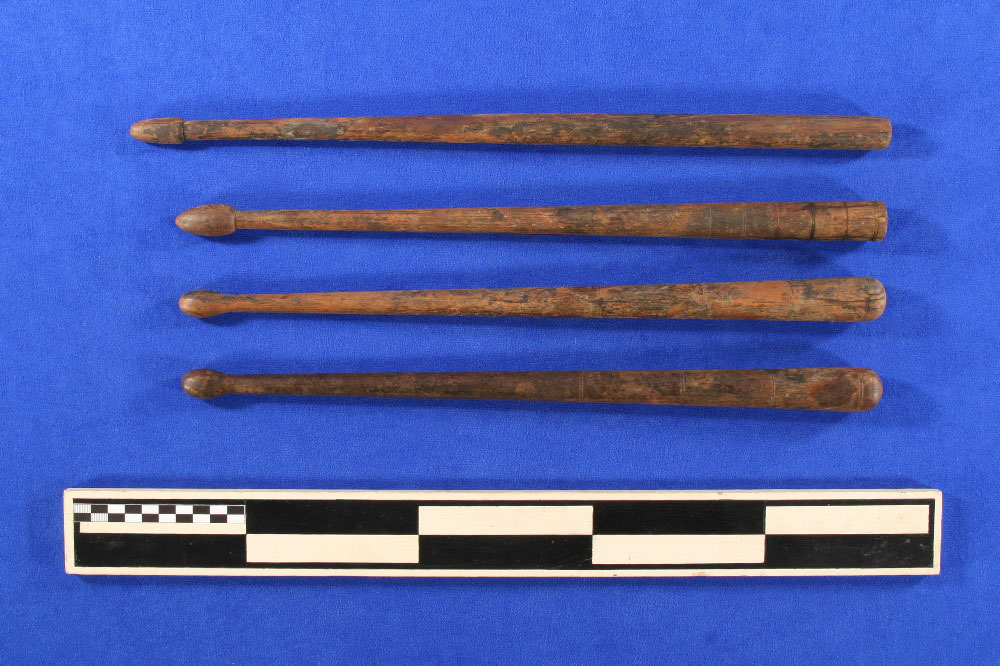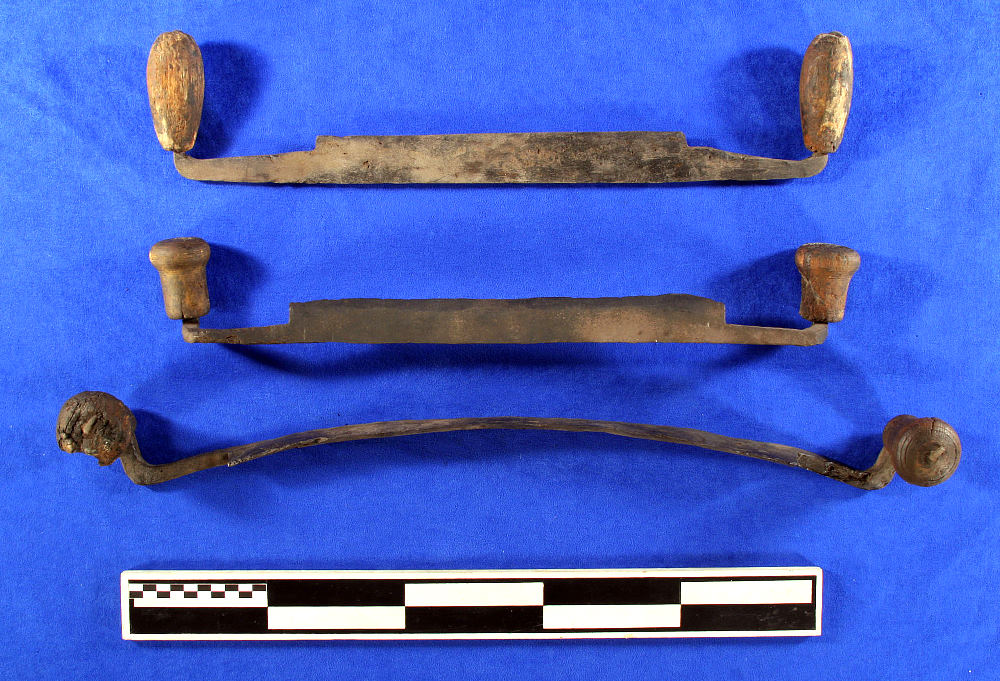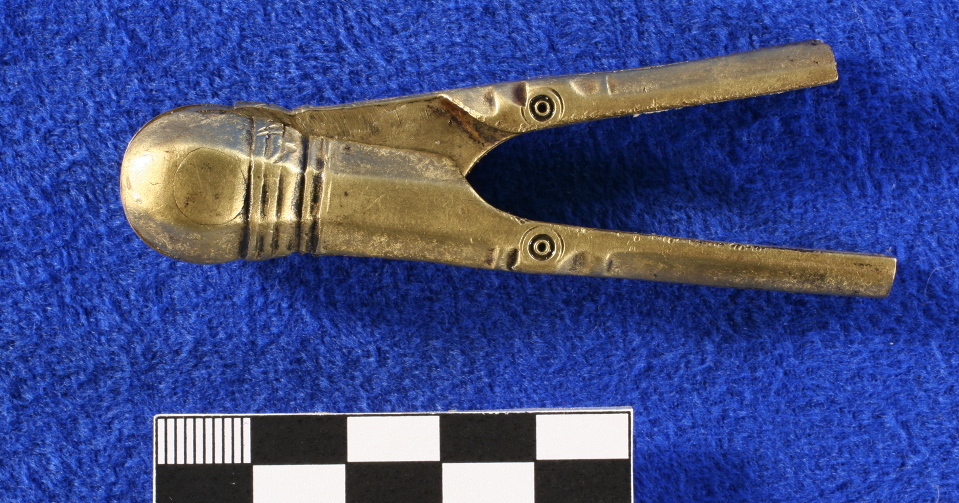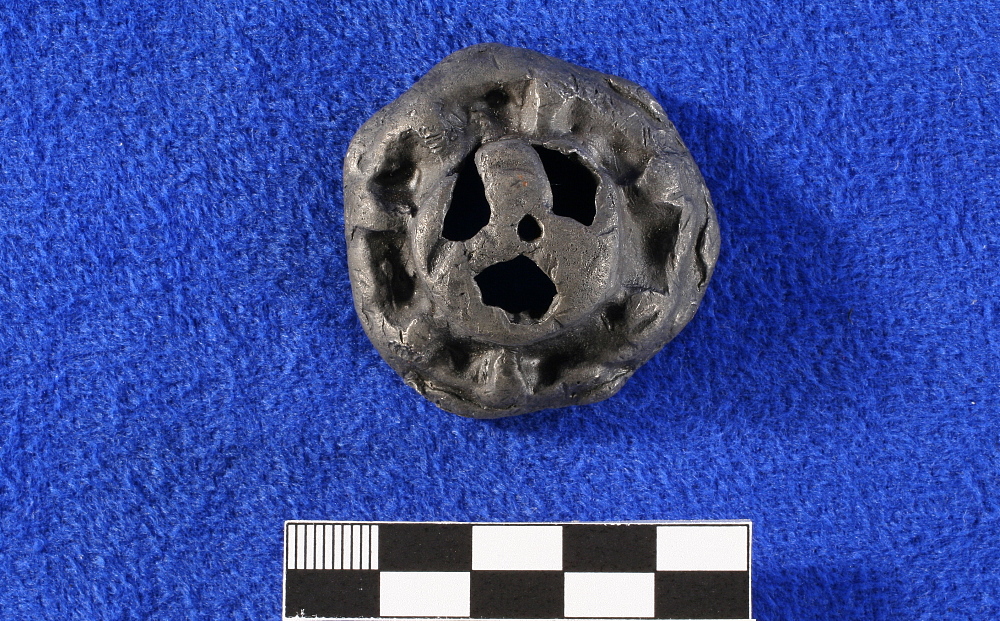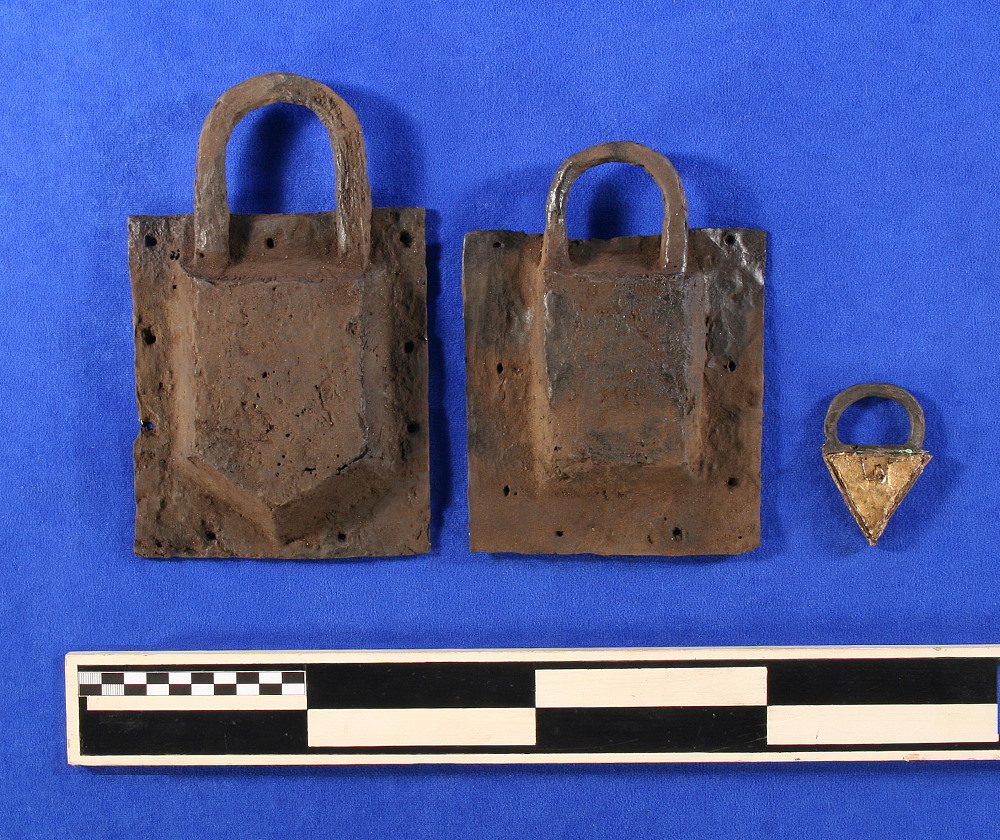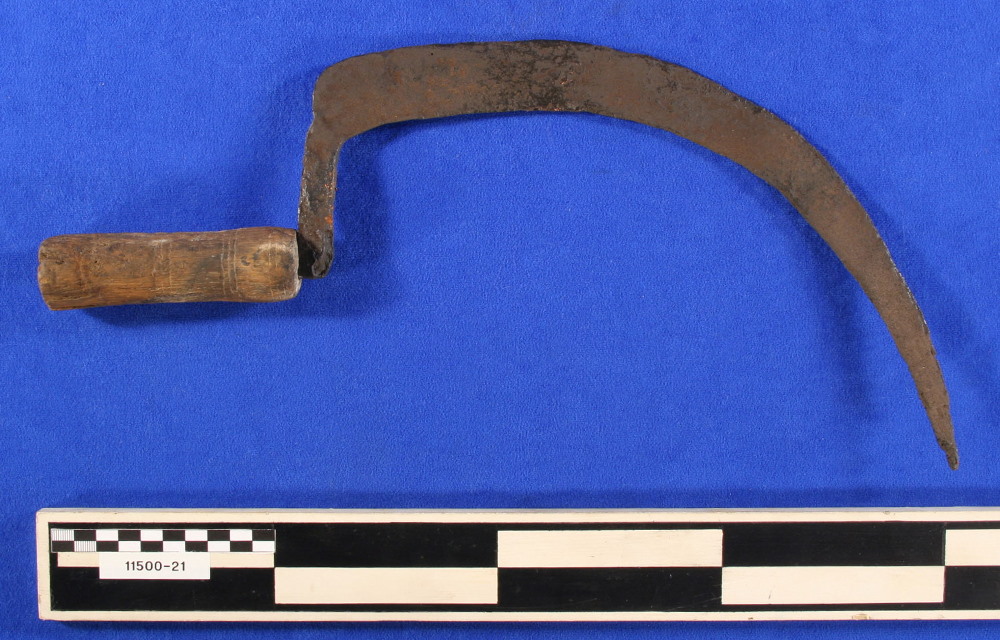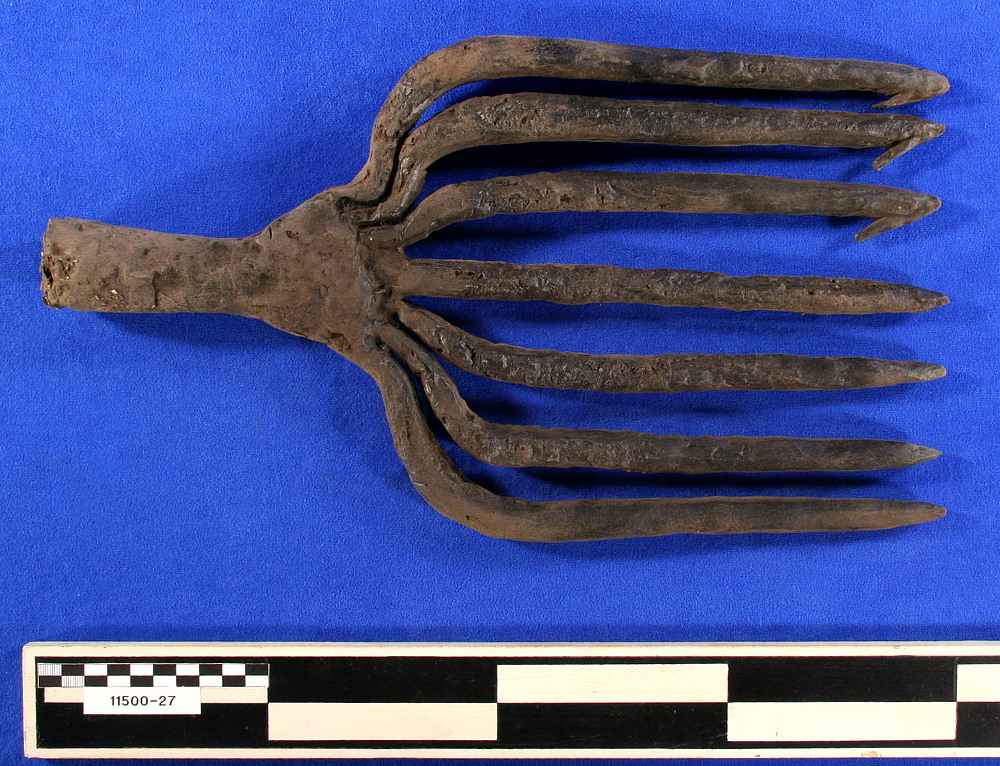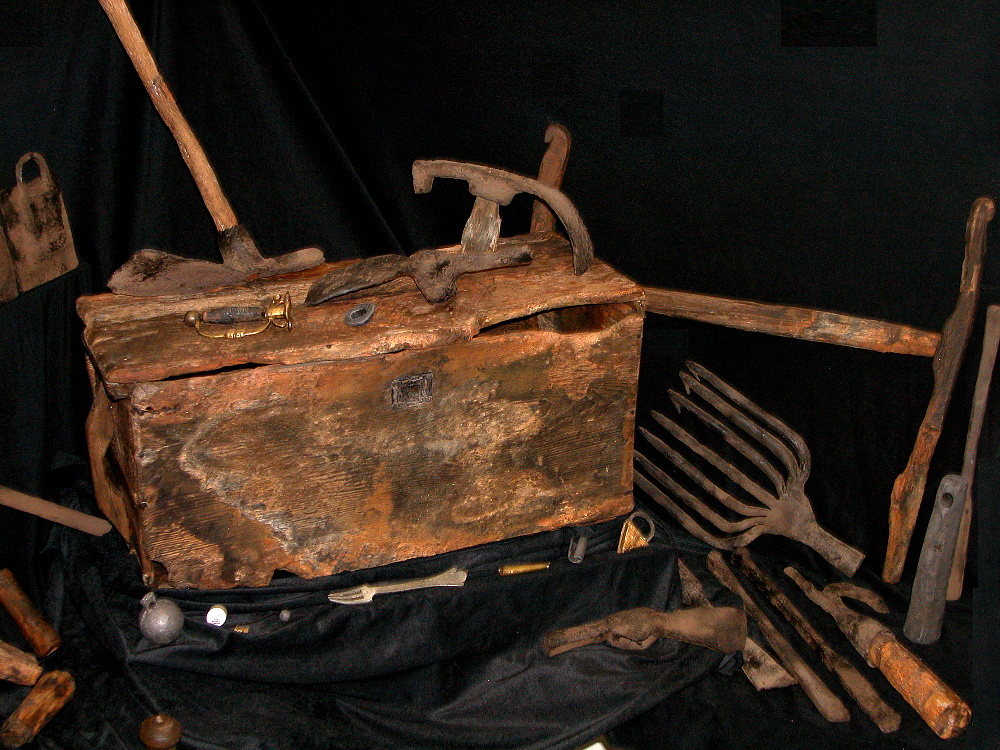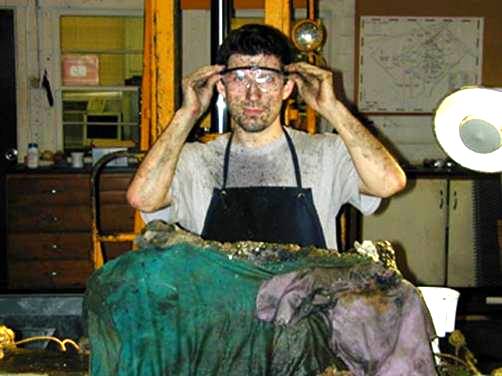"Excavating" the Mystery Chest
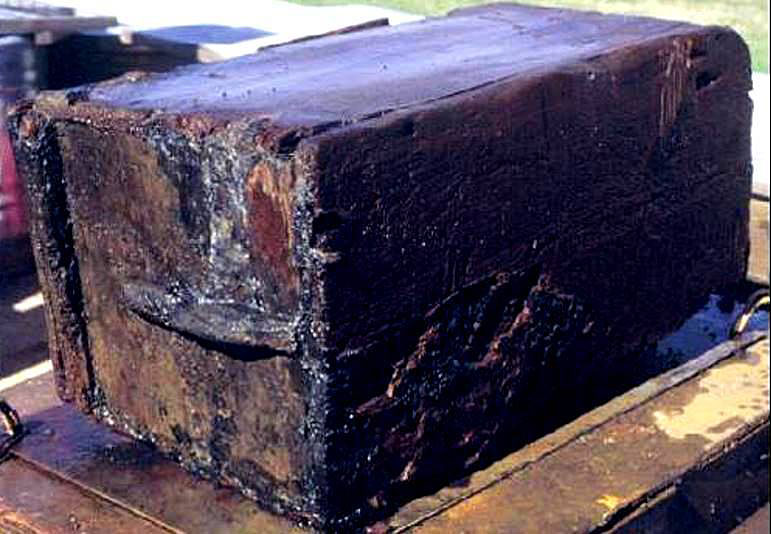 The Mystery Chest, shown prior to opening. Weighing more than 300 lbs before its massively concreted contents were removed, the chest itself is modest in size, measuring only 25 inches long, 13 inches wide, and 13 inches tall. |
Explore the Chest's Concreted ContentsClick or tap to view objects inside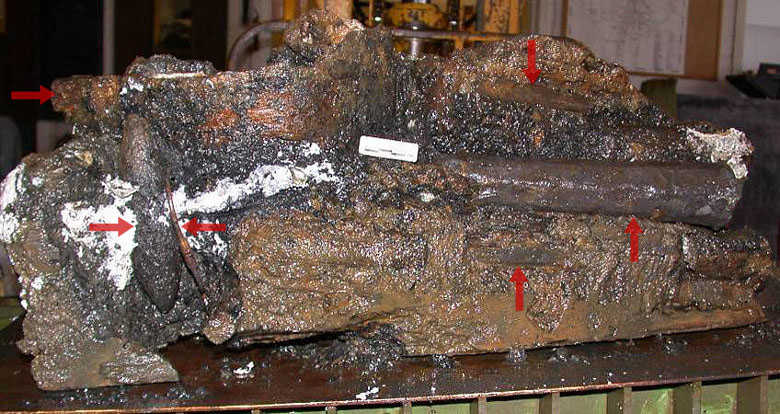
The contents, or internal matrix, of the chest were for the most part concreted into a solid mass, similar to hardened cement. The "excavation" and conservation of the objects involved a variety of different processes based on the materials of which they were made. Explore the contents to view artifacts denoted by red arrows. |
Therefore, a method for preserving the shape of these objects was developed to prevent their total destruction as they were removed from the chest. Lack of physical access to these artifacts further complicated matters because many other objects were lying below, next to, and occasionally intertwined with the one being examined. The method devised to save them was multi-stepped. First, the artifact had to be uncovered carefully, taking into account both its fragility and that of the artifacts around it. A clay wall was then built around the artifact, and a thin layer of RTV silicone rubber was laid over the object. Several layers of marine, epoxy-soaked, carbon-fiber cloth sheets were then immediately placed atop the RTV. A day or two later, when both the RTV and the epoxy had set, the artifact could be carefully wedged out of the chest. The RTV mold detailed the exact surface of the artifact, while the epoxy-soaked carbon fiber sheets preserved the shape of the mold. This technique worked well for keeping the curvature of the adze blades and other complex shapes that would be difficult to reconstruct from fragmented pieces. It was also imperative in helping to reconstruct those iron items that were already so far deteriorated that they did not survive removal from the chest. |
|
Processes for uncovering a mystery object. Conservation of this heavily concreted iron object first entailed chipping away as much of the cement-like covering as possible. The artifact was then covered with epoxy material to preserve its exact surface and shape (center). Following reconstruction from the mold , the unusual object was revealed to be an iron hook with wooden handle, possibly used as a gaff for fishing or as a cattle hook (right ). | ||
Non-Ferrous ObjectsA number of objects made of organic materials were found in the chest and, as a group, were quite well preserved. Some of the wood had originally been sanded, and the smoothness of these surfaces was generally retained. The rope and twine were in poor shape, but sections of textile (possibly canvas or sailcloth) used to wrap the drawknives' blades were extracted and still kept much of their strength. Several other non-iron metallic objects were also inside and were generally found in pristine condition. The brass was still as shiny as it must have been the day the ship sank. The lead and pewter objects were still strong with smooth, clean surfaces. Designs on the brass hilt pieces and a maker’s mark on the pewter fork could not have been better preserved. This was due to the amount of surrounding iron that, as it degraded, contributed electrons to the other, more noble, surrounding metals. The encasing iron concretion also helped save these other metals by forming a barrier against any circulating saltwater. Periodically throughout the examination process, the chest was x-rayed using the CRL industrial radiography machine. For most of the process, the thickness and density of the chest were too great for any image to be made. As the final layers were reached, however, the remaining pewter, lead, and brass items could clearly be seen. Only in the last layer, however, could the wood and iron artifacts be faintly discerned. Multiple layers of an unidentified sheet metal located on the bottom may have provided an additional barrier between the artifacts and the x-ray film. After their removal from the chest, the various artifacts were treated according to their material composition. The brass items underwent electrolytic reduction (ER), as did the pewter fork for a brief period. Lead was chemically cleaned and then sealed with microcrystalline wax. No iron object was strong enough to undergo ER, so epoxy casts were made from molds of these iron objects. Organics (wood, rope, twine, cloth, and fur) were dehydrated to prepare for silicone oil conservation. Drawknives, Drumsticks, and DividersThe first artifact removed posed a mystery until it was determined to be a chape, a brass cone used to protect the tip of a scabbard for a sword. Also revealed were several carpentry tools: a cooper's heading saw, three drawknives, three adzes, a hewing hatchet, two gimlets, an augur with six spare bits, a cooper's axe, a cold chisel, two gouges, a chince, and a carpenter's square. Most, if not all, of these tools were used in cask-making, a specialized job performed by the cooper. Many of the implements directly correlate to the tool design that a French wine-cask cooper would have owned. A succession of odd and seemingly unrelated artifacts from the chest allowed it to live up to its nickname, the “Mystery Chest.” Two sickles used for agricultural clearing or harvesting were recovered, along with four drumsticks (only two of which form a mated pair). There was a pair of brass navigational dividers, a sounding lead with the rope still attached, and a large seven-tined fishing spear. The oddness of these items discovered together in one cache was compounded by the finding of small sword hilt pieces, a well-preserved pewter fork, and three locks (one triangular shaped and two padlock shaped). Two items had different ownership initials etched onto their surfaces, the smallest gimlet (“WF”) and the pewter fork (“OT” or “LO”). The fork also had a maker’s mark consisting of a pair of clasped hands beneath a crown, with the word “FIN” beneath and the name “M CARDIN” above. This name belongs to pewterer Michel Cardin of La Rochelle, France. The fork was the only pewter one found on board La Belle, a circumstance perhaps explained by forks not gaining wide acceptance as a utensil in France until the end of the 17th century among only the elite. Several items have thus far defied satisfactory explanations as to their original purpose. One is a verso-sized lead ball with a large sprue, through which runs a drilled hole. Could this have been a large plum bob, or a sounding lead, or a counter weight of some kind? Another mysterious lead piece consists of a heavy disc with three arms that join in the middle, at which point there is a tiny hole. Might this have been part of a small hand pump, or possibly a drain sieve? Even “identifiable” objects can sometimes create mystery, such as two padlock-like mechanisms called shackle-bolt locks. Although their use as some type of lock is undisputed, the precise circumstances of how something of this design would function are unclear. The padlock portion of the artifact is a single piece of sheet metal with an extra-large flat backing, through which there are a number of holes by which to attach this with nails or screws to some surface. Whatever was to be locked must have been flexible, like a chain, but under what circumstances would something of this complexity be needed? Perhaps these mechanisms were used to chain prisoners to walls. Making Sense of the Mystery ChestThe artifacts, formerly useful items on dry land, are once again able to remain in the dry air, out of the watery environment in which they existed for nearly 325 years. But the sheer diversity of the artifacts in the Mystery Chest inspires many questions. To whom did these items belong? Why were they put together? Was the chest locked? Why was it on board the ship? Historical research, primarily via firsthand reports from the expedition’s survivors, suggests the chest was first loaded on one of La Salle’s other ships, l’Aimable, at the start of the expedition in France. It was then unloaded prior to that vessel’s wrecking at the mouth of Matagorda Bay, loaded onto La Belle, and then taken to the new settlement, Fort St. Louis. The chest was returned to the ship prior to its sinking. This scenario, however, does not explain the chest’s odd combination of objects. Artifact analysis has shown that the chest was a repository for various tools, as well as a sundry collection of seemingly unrelated artifacts. The tools are instruments used in a variety of occupations ranging from that of French wine coopering to those of agricultural, military, and maritime endeavors. In West’s view, the chest’s contents can be viewed as a microcosm for the whole expedition, reflecting the various trades of the settlers. The contents may also shed light on the habits and personality of the expedition’s leader. West believes that most of the items in the chest were probably acquired by La Salle after other members of his party died. Records verify that La Salle often claimed the possessions of the dead and that he ordered La Belle to be reloaded with his personal goods and other supplies in preparation for moving the ship farther up the bay. Before that trip could occur, however, the ship ran aground in the bay and eventually sank. The diversity of the chest’s contents and two artifacts’ bearing different owners’ initials suggest that the “Mystery Chest” may have been a repository for various utilitarian items collected by La Salle before the loss of La Belle in January of 1686. Together, they are faint reminders of the people who accompanied the French explorer on his fatal journey to the New World. Editor's note: This section was adapted from a webpage by Michael West and Donny L. Hamilton originally appearing on the Texas A&M Conservation Research Laboratory website. The analysis and conservation of the contents of the chest, comparison with similar artifacts from other sites, and historical research into the origins of the chest and its artifacts was the subject of West's Master of Arts thesis in 2005. |
|
